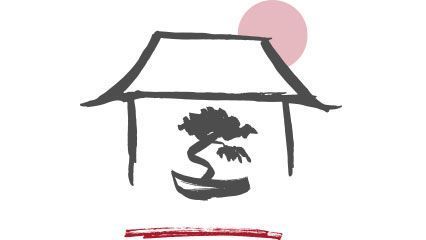Bonsai, small as they may be, are “as trees as their big brothers”. If we understand this well, it will not be difficult for us to understand where to locate the bonsai.
Bonsai have to live where they get sun and oxygen, where they can receive the rain with joy and, above all the humidity of the night reaches them well. A terrace, balcony, garden or simply a window will be the ideal place to place our Bonsai. Naturally, high temperatures and strong summer sun or winter frost can affect them.
When these extreme temperatures come, bonsai will appreciate that we protect them. But as soon as the moment of danger has passed, we will put the trees back where they live comfortably.


How to protect trees from the summer heat?
Trees draw water from the ground through their roots and conduct it through the trunk and branches to the leaves. The leaves evaporate a large amount of water. If the weather is hot and dry, the leaves evaporate even more water, much like clothes on the line dry much faster on sunny and windy days.
Even if we don’t stop watering them, if the heat is extremely strong, the leaves may evaporate more water than what reaches them through the roots. If this happens, we can get burns on the tips of the leaves, especially in trees with large and tender leaves. To prevent this from happening, we will place the bonsai sheltered from the wind and sun, simply leaving them in the semi-shade of a larger tree or plant.

Frost protection
When winter comes temperatures drop. Bonsai reduce their activity and prepare to withstand the cold. If the temperatures are not extremely low, even if it freezes at night, most of our trees do not need any special protection.
This is not valid for tropical species of bonsai , called indoor, which, even if it does not freeze, cannot withstand low temperatures. These trees of tropical origin must be protected from the cold, placing them where frost does not reach, in a greenhouse or bringing them inside the house.

¿How to place your bonsai indoors?
There are no indoor plants but indoor conditions that allow the cultivation of the plants. Bonsai are no exception to the aforementioned rule. As we have seen, whenever possible, bonsai should be properly located outdoors. This does not prevent them from living indoors, even for long periods. However, the adequate conditions for the development of a tree are rarely present indoors: there is a lack of light and humidity, which limits the life of the bonsai. The adaptation of a bonsai to the interior of a house will depend on whether its placement meets the following conditions of light and humidity:
Light: the ideal location to place a bonsai at home is always very close to a large, well-lit window (without curtains). The maximum distance to the window will be approximately one and a half meters.
Humidity: the environment indoors is generally too dry for the proper development of the trees. The best place to keep the bonsai inside the house will be a cool room, and we will place them away from heating devices, fireplaces or electrical appliances that give off heat such as the television.

What species are best suited indoors?
In general, bonsai of tropical species (Ficus, Sageretia, Zelkova, Serisa, Carmona, etc.) resist indoor conditions better.
At the other extreme, conifers and deciduous trees (pines, junipers, beeches, etc.) resist poorly or do not resist indoor conditions.
In the image you can see a Sageretia, a variety that adapts perfectly to indoors. If you want to see all the indoor varieties, click here.

